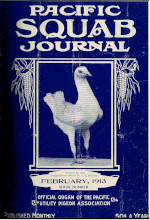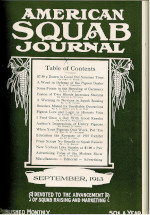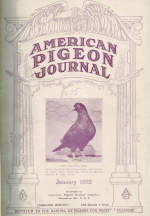
All of the issues in the cote's possession for the Pacific Squab Journal, the American Squab Journal and the American Pigeon Journal through 1959 are now complete. Unfortunately some years/issues are missing. They are noted in red in the table. They can be read on line or downloaded completely free of charge.. Select them by clicking the issue number. . Even if you have the hard copies, use these files for research and reading rather than your fragile hard copies
|
||||||
 |
||||||
A magazine's covers really tell a good tale of what was going on in the hobby at the time. The first few issues of the PSJ displayed photographs of utility breeds on the cover, but this quickly changed to displaying the table of contents there, starting with the April-May issue. (Many more pigeon magazine covers can be seen at the website pigeoncote.com, including those of the Purebred Pigeon). Then, as now, pigeon magazines needed the breeders and breeders needed the magazines in order to flourish. And flourish we have. More than a hundred years later, there are breeders in every part of the nation and so is our modern magazine, the Purebred Pigeon. |
|
 |
The prize that never was. In the month just before Frank Hollmann became the owner, an insert in the September issue offered a $10 gold piece prize for the best article submitted on modern squab raising. Of course you had to be a subscriber to take advantage of it. Perhaps it was the last hurrah, for keeping the magazine afloat. In any event, the magazine changed hands, Frank Hollmann became the owner, and nothing was ever heard of the contest or prize again. Going National. The emphasis of the articles also changed from featuring only utility breeds to including fancy pigeons. The ads also changed, quickly including ads for stock, feed, and supplies from all over the country. It is no small wonder, then, that the magazine's name was changed so quickly from the Pacific Squab Journal to the American Squab Journal, starting with the July issue of that first year, 1913. Wm. J. Reid became the publisher. The name change was announced in the June issue of the PSJ - “Beginning with the July number, this magazine will appear as the American Squab Journal.” The newly named magazine started as volume 2. Interestingly, an article in the August issue of 1913 mentioned that seamless bands should be used to put an end to the disreputable practice of old birds being peddled as young. While I suspected it was possible that this practice had been going on, I wondered if this might have been just a way of getting breeders interested in buying seamless bands, a sort of advertising ploy. However, there was not an accompanying ad for seamless bands in that issue, and, in fact, there were no ads for seamless bands For almost two years. The first ad for seamless bands was in the May 1915 issue .During 1914, the magazine was acquired by E. W. Nichols, and moved to Kansas City. He retained the name of the American Squab Journal and the original masthead - “Devoted to the the Advancement of Squab Raising and Marketing,” The magazine changed hands often. Frank Hollmann, an original subscriber, became publisher for the October issue of 1915. Frank had been a devoted subscriber, but clearly had a broader perspective.
|
 |
Hollmann retained the name of the American Squab Journal and the masthead up until May of 1920. Then he radically changed the focus to all breeds, renaming it the e American Pigeon Journal. This was also reflected in the slightly, but significantly, altered new masthead - “Devoted to the Raising of Pigeons for Profit & Pleasure.” And to put an exclamation point to it, this issue was devoted to the Maltese. Perhaps the first special ever issued. This does not imply, however, that before 1920 the magazine was not an excellent source for information on what we now consider fancy breeds. In those older issues, there is a plethora of articles on Hungarians, Runts, Carneaux, Maltese, Mondaines, Homers, and of course, Kings. |
|||||
. |
||||||
| Pigeons and the Wider World No hobby exists in isolation, and articles about the devastating war ravaging Europe are found throughout those years, even though the United Sates had not yet entered the conflict. Starting with the September issue of 1917, readers were urged to place a one cent stamp on the cover of the magazine and to give it to the postman. Magazines so stamped would be delivered to soldiers on the front. Would it not be grand to find a copy with that one cent stamp on the cover! A year later, the entire issue was devoted to pigeons being used in the war effort. We don't normally think about pigeon magazines providing this sort of in depth information, complete with abundant photos. But why not? It is a pigeon magazine after all. What better source and audience could one find? | ||||||
| View the issues covers | ||||||
![]()
This work (Pigeoncote, by John Verburg), is free of known copyright restrictions.